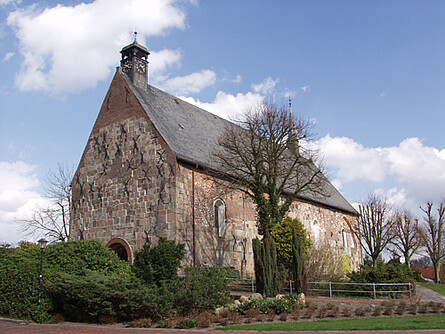The Quaternary Ice Ages and the Erratic Boulder Churches in East Frisia and Oldenburg
The churches in the East Frisia-Oldenburg region represent an element of landscape history. While the churches in the sea marshes were built of brick, the Geest-Churches (churches built in the area of Pleistocene sandy soils, also known as Erratic Boulder Churches) were constructed using granite and metamorphic rocks which had been transported into the area of Northern Germany by the glaciers of the last ice age. The erratic boulders used in the churches’ construction come from the surrounding area and reflect the local drift geology. Drift deposits whose exact origins have been identified due to their typical composition are known as marker deposits. Mapping the distribution of drift marker deposits allows reconstructing the transport routes of Scandinavian glacial deposits by various ice streams during the Saale and Elster glaciations.The mapping of crystalline rock used in the construction of churches contributes towards the qualitative survey of glacial drift in the area of Lower Saxony. Leaflets describing the rocks of a church wall up to eye level have been prepared for the churches at Bockhorn, Friesland District, as well as Asel and Marx, both in the district of Wittmund.
Bibliography
Bungenstock, F. (2016): Der Büppeler Findling. Evangelisch-Lutherische Kirchengemeinde Varel - Internetveröffentlichung
Bungenstock, F., Meyer, K.-D. (2013): Findlingsquader-Kirchen der Ostfriesisch-Oldenburgischen Geest und die Eiszeit-Theorien. Nachrichten des Marschenrates zur Förderung der Forschung im Küstengebiet der Nordsee, 50: 49-55.
Bungenstock, F., Meyer, K.-D. (2012): Die Kirche von Asel und ihre geologischen Besonderheiten. Faltblatt, Niedersächsisches Institut für historische Küstenforschung, Wilhelmshaven.
Bungenstock, F., Kammerer, P., Ratz, B. (2007): Geologischer Steingarten am Niedersächsischen Institut für historische Küstenforschung, Wilhelmshaven. Faltblatt. Niedersächsisches Institut für historische Küstenforschung, Wilhelmshaven.
Riepshoff, H., Bungenstock, F. (2005): Wie die Mauern der Bockhorner Kirche die Geschichte der Eiszeiten erzählen. Faltblatt, Niedersächsisches Institut für historische Küstenforschung, Wilhelmshaven.

